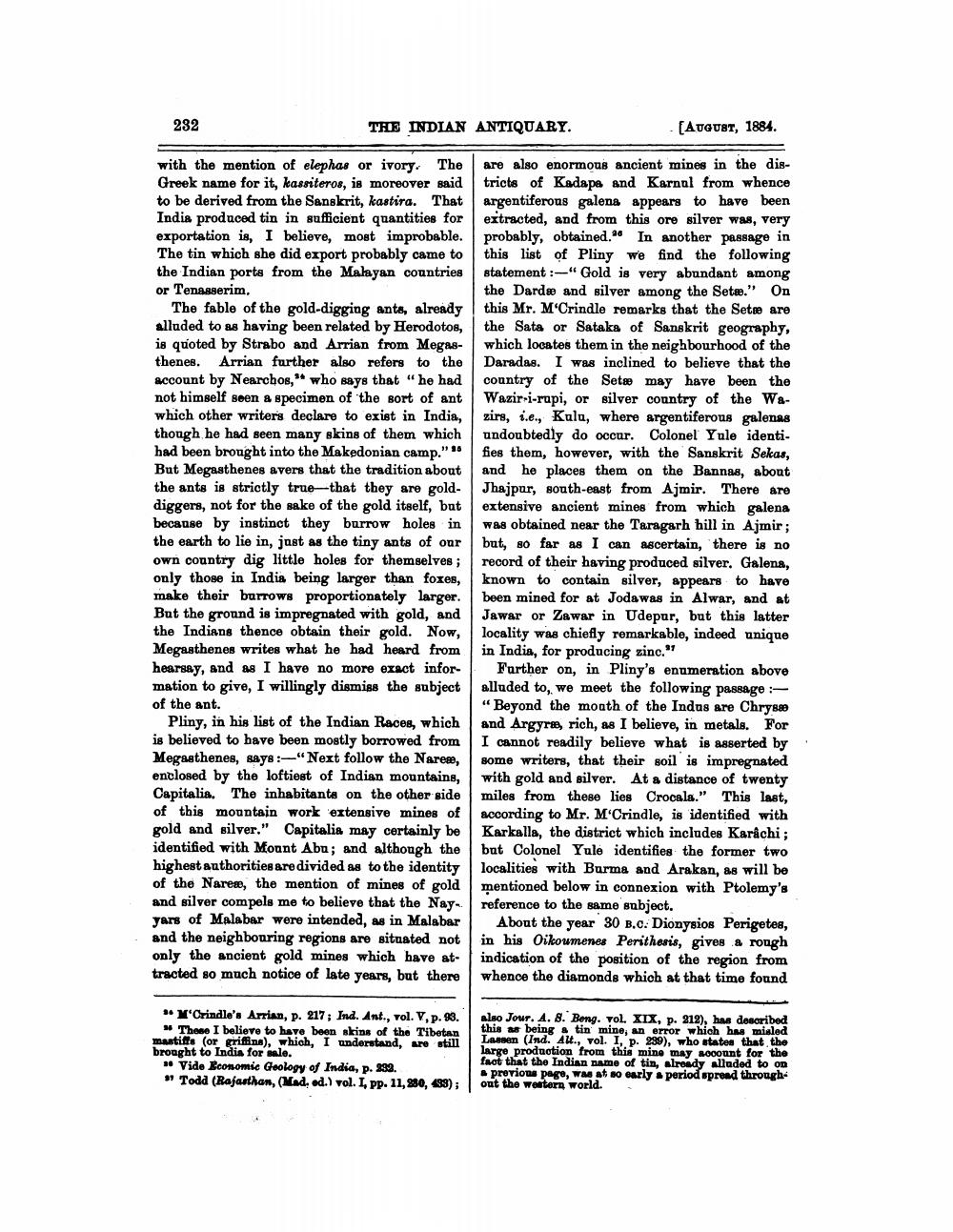________________
232
THE INDIAN ANTIQUARY.
with the mention of elephas or ivory. The Greek name for it, kassiteros, is moreover said to be derived from the Sanskrit, kastira. That India produced tin in sufficient quantities for exportation is, I believe, most improbable. The tin which she did export probably came to the Indian ports from the Malayan countries or Tenasserim.
The fable of the gold-digging ants, already alluded to as having been related by Herodotos, is quoted by Strabo and Arrian from Megasthenes. Arrian further also refers to the account by Nearchos," who says that "he had not himself seen a specimen of the sort of ant which other writers declare to exist in India, though he had seen many skins of them which had been brought into the Makedonian camp." " But Megasthenes avers that the tradition about the ants is strictly true that they are golddiggers, not for the sake of the gold itself, but because by instinct they burrow holes in the earth to lie in, just as the tiny ants of our own country dig little holes for themselves; only those in India being larger than foxes, make their burrows proportionately larger. But the ground is impregnated with gold, and the Indians thence obtain their gold. Now, Megasthenes writes what he had heard from. hearsay, and as I have no more exact information to give, I willingly dismiss the subject of the ant.
Pliny, in his list of the Indian Races, which is believed to have been mostly borrowed from Megasthenes, says: "Next follow the Nares, enclosed by the loftiest of Indian mountains, Capitalia. The inhabitants on the other side of this mountain work extensive mines of gold and silver." Capitalia may certainly be identified with Mount Abu; and although the highest authorities are divided as to the identity of the Nares, the mention of mines of gold and silver compels me to believe that the Nayyars of Malabar were intended, as in Malabar and the neighbouring regions are situated not only the ancient gold mines which have attracted so much notice of late years, but there
[AUGUST, 1884.
are also enormous ancient mines in the districts of Kadapa and Karnal from whence argentiferous galena appears to have been extracted, and from this ore silver was, very probably, obtained. In another passage in this list of Pliny we find the following statement:-"Gold is very abundant among the Dardee and silver among the Sete." On this Mr. M'Crindle remarks that the Setee are the Sata or Sataka of Sanskrit geography, which locates them in the neighbourhood of the Daradas. I was inclined to believe that the country of the Sets may have been the Wazir-i-rupi, or silver country of the Wazira, i.e., Kulu, where argentiferous galenas undoubtedly do occur. Colonel Yule identifies them, however, with the Sanskrit Sekas, and he places them on the Bannas, about Jhajpur, south-east from Ajmir. There are extensive ancient mines from which galena was obtained near the Taragarh hill in Ajmir; but, so far as I can ascertain, there is no record of their having produced silver. Galena, known to contain silver, appears to have been mined for at Jodawas in Alwar, and at Jawar or Zawar in Udepur, but this latter locality was chiefly remarkable, indeed unique. in India, for producing zinc."
Further on, in Pliny's enumeration above alluded to, we meet the following passage :"Beyond the mouth of the Indus are Chryss and Argyra, rich, as I believe, in metals. For I cannot readily believe what is asserted by some writers, that their soil is impregnated with gold and silver. At a distance of twenty miles from these lies Crocala." This last, according to Mr. M'Crindle, is identified with Karkalla, the district which includes Karâchi; but Colonel Yule identifies the former two localities with Burma and Arakan, as will be mentioned below in connexion with Ptolemy's reference to the same subject.
About the year 30 B.C. Dionysios Perigetes, in his Oikoumenes Perithesis, gives a rough indication of the position of the region from whence the diamonds which at that time found
M'Crindle's Arrian, p. 217; Ind. Ant., vol. V, p. 93. These I believe to have been skins of the Tibetan mastiffs (or griffins), which, I understand, are still brought to India for sale.
s Vide Economic Geology of India, p. 233.
37 Todd (Rajasthan, (Mad, ed.) vol. I, pp. 11, 230, 499);
also Jour. A. 8. Beng. vol. XIX, p. 212), has described this as being a tin mine, an error which has misled Lassen (Ind. Alt., vol. I, p. 239), who states that the large production from this mine may account for the fact that the Indian name of tin, already alluded to on a previous page, was at so early a period spread through out the western world.




